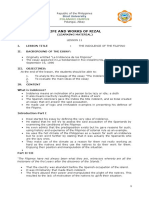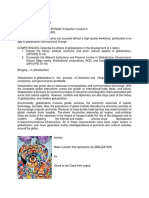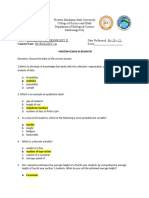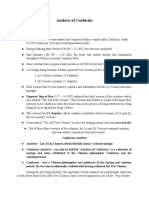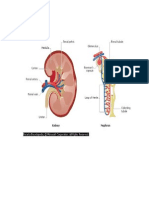Administration in Indian Villages
Administration in Indian Villages
Uploaded by
Anupam ChatterjeeCopyright:
Available Formats
Administration in Indian Villages
Administration in Indian Villages
Uploaded by
Anupam ChatterjeeCopyright
Available Formats
Share this document
Did you find this document useful?
Is this content inappropriate?
Copyright:
Available Formats
Administration in Indian Villages
Administration in Indian Villages
Uploaded by
Anupam ChatterjeeCopyright:
Available Formats
Administration in Indian Villages - Informative & researched article on Administ ration in Indian Villages Indian Villages in ForumArticles Art
& Culture Entertainment Health Reference Sports Society TravelForum E-magazine Free
Indian Villages : Indian Villages l Indian Village Art l Indian Village Life l I ndian Village Festivals l Indian Village Transport l Indian Dalits l Indian Pura nic Villages l Villages of Goa l Villages of Gujarat l Villages of Haryana l Vil lages of Jammu and Kashmir l Villages of Himachal Pradesh l Villages of Jharkhan d l Villages of Karnataka l Villages of Meghalaya l Villages of Maharashtra l Vi llages of Nagaland l Villages of Mizoram l Villages of Tripura l Villages of Ori ssa l Villages of Sikkim l Villages of Punjab l Villages of Uttarakhand l Villag es of West Bengal l Indian Village Society l Villages of Tamil Nadu l Villages o f Madhya Pradesh l Villages of Rajasthan l Dowlaiswaram l Khonoma l Villages of Alappuzha l Villages of Bihar l Villages of Chhattisgarh l Rural Population in I ndia Home > Society > Indian Villages > Indian Villages > Administration in Indian Vi llages
Administration in Indian Villages Administration in Indian Villages has seen significant changes from ancient peri od to contemporary period.
The administration in Indian villages can trace its origin back to the ancient p eriod. The current administration structure in the Indian villages was built up by the Mauryan emperors several centuries ago. Since then, the administration in the Indian villages has undergone several significant changes. Different foreig n invaders changed the Indian village administration according to their own admi nistrative set-up from time to time. However, the basic administration structure of Indian villages was quite common in the ancient, medieval and modern period. The Mauryan emperors introduced the Gram Sabha system for the first time in Indi an villages. This system is considered the base of administration in Indian vill ages since then. The Gram Sabha in Mauryan period comprised a Headman and a few other members. The Sabha used to take decision about any issues related to the v illage and they enjoyed several powers. The decision of Gram Sabha was considere d Law and the villagers were bound to obey the Sabha`s instructions. However, though the Gram Sabha enjoyed supreme the Sabha had to take some other matters into cision. The religious customs and beliefs were he Gram Sabha could not take any decision that n. Apart from that, the Gram Sabha also had to power, the Headman and members of consideration while taking any de one of the foremost among them. T would violate the laws of religio take decisions considering the cu
ltural aspects of the village life. As the caste system of Hinduism was strictly maintained during that period, the Brahmans used to enjoy most of the powers in Gram Sabha. There were no representatives from lower castes in the Sabha. The administration in Indian villages witnessed the existence of the Gram Sabha for several centuries. With the course of time, the Gram Sabhas were started to be controlled by the Jamindars or Landlords. The Headman of the Gram Sabha was a lso bound to report to the Jamindars in certain occasions. During the medieval p eriod, the administration in Indian villages saw the chiefdoms in existence. The Chiefdoms comprised the Gram Sabhas of a few villages and they were under total control of the Kingdom. The Mughals ruled India for a major part of the medieva l period and hence, these changes were mainly brought upon by them. This adminis trative system continued to be in practice in the Indian villages till the end o f the Mughal period, with little occasional changes. However, the British rulers made some significant changes in the entire administ ration in Indian villages. The centuries old administration policy of Gram Sabha or local governance in India was demolished by the British rulers and they star ted to unite all the villages under one umbrella. They actually centralised the entire administrative system of India and hence, the Gram Sabhas or Panchayats g radually started to lose their importance. The British rulers also tried to intr oduce local self-governments in the villages. They implemented certain general l aws for all the local self-governments in the villages. After Independence, the administration in Indian villages partially went back to the administrative structure followed during the ancient period. The Government of India decided to implement the local self-government system in all the villa ges of India where the villages would be governed by a Panchayat Committee. This committee was somewhat identical to the Gram Sabha. The difference is that the members in the Panchayat Committee are elected democratically through general el ections and the adult villagers cast their votes to put their favourite person i nto the Committee. The Panchayat Committee looks after all kinds of issues relat ed to the village and also tries to establish law and order in the village. In c ontemporary India, the Panchayat Committees are constitutional bodies that enjoy autonomy in most of its activities. However, they are subject to contact the St ate Governments in certain issues and they actually work under the supervision o f the State Governments. Administration in Indian villages is considered one of the most scientifically s tructured administrative systems of all time. The administration was planned in such a way that people from all strata of the village society could participate in the decision making process. The ancient concept of Gram Sabha is still in ex istence in the name of Panchayat in the Indian villages. However, the Panchayati Raj System is more democratic in nature compared to that of Gram Sabha system, as the common men elect the members of Gram Panchayat in modern India. (Last Updated on : 7/01/2010)
Share this Article 0 0 0StumbleUpon0Digg0ShareThis1 More Articles in Indian Villages Occupation in Indian Villages Administration in Indian Villages History of Indian
Villages Villages of Uttar Pradesh
Recently Updated Articles in Indian Villages Indian Village Life Indian Village Life reflects the simple way of living. The simplicity and unity of the innocent villagers, their superstitions, beliefs, cultures, serenity make their life complete. Occupation in Indian Villages Occupation in Indian villages varies greatly from Agriculture to fishing, weavin g, cottage industry, handicrafts, cottage industry, pottery, carpentry, leather work and others. Villages of Punjab Villages of Punjab hold key to the state s economical, industrial and agricultural strength. A major part of the state population stays in villages. Village Life in South India Village life in South India is highly dependent on agriculture and fishing. The life in villages in southern part of India is rich in tradition and culture. Pottery in Indian Villages Pottery in Indian villages traces back to the Indus Valley Civilisation. The art of handling of clay is called Pottery and it is one of the earliest skills know n to the Indians.
E-mail this Article
Post a Comment
Follow Indianetzone.com
Forum Forum on Indian Villages Discuss Now Free E-magazine Subscribe to Free
E-Magazine on Indian Crafts
Administration in Indian Villages - Informative & researched article on Administ ration in Indian Villages Sitemap Contact Us RSS Feeds Copyright 2008 Jupiter Infomedia Pvt. Ltd. All rights reserved including the rig ht to reproduce the contents in whole or in part in any form or medium without t he express written permission of Jupiter Infomedia Pvt. Ltd.
You might also like
- Dark Sun - Mind Lords of The Last SeaDocument144 pagesDark Sun - Mind Lords of The Last Seageisha6992% (13)
- Lister Hr3 ManualDocument119 pagesLister Hr3 ManualRichard Gomez Cueva100% (2)
- Parts of Boiler and Their FunctionDocument4 pagesParts of Boiler and Their FunctionsadNo ratings yet
- Nasm 20470Document8 pagesNasm 20470Dheeraj GundNo ratings yet
- Chapter 6 Activities Interdisciplinary TeachingDocument19 pagesChapter 6 Activities Interdisciplinary TeachingMichael Martinez100% (1)
- Deliberate Acts of TeachingDocument1 pageDeliberate Acts of Teachingapi-3724678No ratings yet
- Ap7 PDFDocument240 pagesAp7 PDFJoyce Dela Rama Juliano86% (7)
- Types of Livelihood in The PhilippinesDocument60 pagesTypes of Livelihood in The PhilippinesSavion Sander AlinaNo ratings yet
- Earth, Wind & Fire - September Lyrics - Genius Lyrics PDFDocument8 pagesEarth, Wind & Fire - September Lyrics - Genius Lyrics PDFFacebookNo ratings yet
- Hochul Dossier, Volume III - ImmigrationDocument2 pagesHochul Dossier, Volume III - ImmigrationTeachoutWuCampaignNo ratings yet
- 2018 - APG7Q3 (1) (Repaired)Document244 pages2018 - APG7Q3 (1) (Repaired)Hannah Andrea Laparan100% (1)
- Grade 7-10 Araling PanlipunanDocument21 pagesGrade 7-10 Araling PanlipunanCherry Mae Morales BandijaNo ratings yet
- South Asian Contribution To CivilizationDocument24 pagesSouth Asian Contribution To Civilizationjolinamariz50% (2)
- Endangered LandscapesDocument55 pagesEndangered LandscapesRaquel Ross50% (2)
- University of Rizal System: Causes of Early Parenthood in Baranggay San Jose Rodriguez, RizalDocument21 pagesUniversity of Rizal System: Causes of Early Parenthood in Baranggay San Jose Rodriguez, Rizaleira may floresNo ratings yet
- 18-1 - The Ottomans Build A Vast EmpireDocument5 pages18-1 - The Ottomans Build A Vast Empireapi-304649470No ratings yet
- The Framework of Materials and MethodsDocument23 pagesThe Framework of Materials and MethodsFrancis DumanigNo ratings yet
- San Carlos City, PangasinanDocument2 pagesSan Carlos City, Pangasinansherla TorioNo ratings yet
- Lesson 4Document2 pagesLesson 4Lovelyn MaristelaNo ratings yet
- Uses of Maps and GlobesDocument33 pagesUses of Maps and GlobesRosmie Jane CantongNo ratings yet
- G7 Q1 L2 Landforms and Waterforms of Asia and Its ImplicationsDocument31 pagesG7 Q1 L2 Landforms and Waterforms of Asia and Its ImplicationsAlyssa Fae CajayonNo ratings yet
- Which CORRECTLY DescribeDocument4 pagesWhich CORRECTLY DescribeMarlou Anthony CandelNo ratings yet
- Acts of Teaching Chapter 6Document3 pagesActs of Teaching Chapter 6api-350475725No ratings yet
- CBAR FormatDocument3 pagesCBAR FormatGemma Taynan LinoNo ratings yet
- Lesson Plan (Generic Competency Model)Document8 pagesLesson Plan (Generic Competency Model)Mystica BayaniNo ratings yet
- Rationale For Teaching Social StudiesDocument7 pagesRationale For Teaching Social Studiesapi-283223689No ratings yet
- Factors Influencing Student Interest in Araling Panlipunan Subject Among Junior High SchoolDocument16 pagesFactors Influencing Student Interest in Araling Panlipunan Subject Among Junior High SchoolJoshua AseritNo ratings yet
- Learning Episode: Physical and Personal Aspects of Classroom ManagementDocument17 pagesLearning Episode: Physical and Personal Aspects of Classroom ManagementPrincess MonasterialNo ratings yet
- Industrial and Labor Management ConflictDocument27 pagesIndustrial and Labor Management ConflictNeshia May Bariquit100% (2)
- Course Activity 11 - SS19Document9 pagesCourse Activity 11 - SS19Christine Joy MarcelNo ratings yet
- CM 4 Sse 18 Law Related StudiesDocument6 pagesCM 4 Sse 18 Law Related StudiesLyka100% (1)
- Landscape Topic Paper 1Document10 pagesLandscape Topic Paper 1MarkNo ratings yet
- Chinese and Japanese CivilizationsDocument83 pagesChinese and Japanese CivilizationsAil Dela RosaNo ratings yet
- Detailed Lesson Plan - Imperialism and ColonialismDocument8 pagesDetailed Lesson Plan - Imperialism and Colonialismmatt andren100% (1)
- Book Review in Development StudiesDocument7 pagesBook Review in Development StudiesAdrian AsiNo ratings yet
- Factors That Influence Decision MakingDocument5 pagesFactors That Influence Decision MakingJosh LeBlancNo ratings yet
- Araling PanlipunanDocument36 pagesAraling PanlipunanTemoteo L. Pupa IIINo ratings yet
- The Neoclassical CounterrevolutionDocument2 pagesThe Neoclassical Counterrevolutiondede nicole100% (1)
- Fiscal Policy 8 - Drawbacks and Limitations of Fiscal PolicyDocument2 pagesFiscal Policy 8 - Drawbacks and Limitations of Fiscal PolicyZeeshan HashmiNo ratings yet
- Roman Civilization Lesson PlanDocument5 pagesRoman Civilization Lesson Planmatt andrenNo ratings yet
- Figure of SpeechDocument15 pagesFigure of SpeechFelrin ClarosNo ratings yet
- A Detailed Lesson Plan in Social Studies of SeniorDocument3 pagesA Detailed Lesson Plan in Social Studies of SeniorJoyce TumbagaNo ratings yet
- Life and Works of Rizal: (Learning Material)Document2 pagesLife and Works of Rizal: (Learning Material)Noah Ras LobitañaNo ratings yet
- The Ancient Near East: Lesson III: Part II (C and D)Document29 pagesThe Ancient Near East: Lesson III: Part II (C and D)Joven Ian MarquezNo ratings yet
- Students Knowledge Level of Modular TeacDocument30 pagesStudents Knowledge Level of Modular TeacStefan GonzalesNo ratings yet
- Fiscal Policy DefinitionsDocument4 pagesFiscal Policy Definitionsreda_sayedsNo ratings yet
- Lesson 2:: The Family Today: Declining or Changing?Document73 pagesLesson 2:: The Family Today: Declining or Changing?Rovien VivasNo ratings yet
- SST 205Document32 pagesSST 205Rhea GalgoNo ratings yet
- City Politics and The EnvironmentDocument19 pagesCity Politics and The EnvironmentIra Dale Valdez100% (1)
- Places - Threats To NatureDocument6 pagesPlaces - Threats To NatureJEEHAN DELA CRUZNo ratings yet
- Detailed Lesson Plan (DLP) Format: Luray Ii Barangay High SchoolDocument2 pagesDetailed Lesson Plan (DLP) Format: Luray Ii Barangay High SchoolNat-Nat Purisima50% (2)
- The Philippines in The 19th Century As Rizal's ContextDocument8 pagesThe Philippines in The 19th Century As Rizal's ContextSunshine C GanteNo ratings yet
- Ofw - Ap10Document6 pagesOfw - Ap10Maria Rebecca CorazonNo ratings yet
- Name: Banag, MC Adrienne Rey K. Course/Year: BS BIOLOGY 1ADocument5 pagesName: Banag, MC Adrienne Rey K. Course/Year: BS BIOLOGY 1AJames Carbonell Dela PeñaNo ratings yet
- Learning Task SummerDocument40 pagesLearning Task Summeremorej1982100% (22)
- Ge108 EthicsDocument1 pageGe108 EthicsVincent Delos Santos100% (1)
- Semester Reflection EssayDocument3 pagesSemester Reflection Essayapi-302726412No ratings yet
- International Dependence RevolutionDocument14 pagesInternational Dependence RevolutionPrincess Raniah Acmad50% (2)
- LESSON 7 - Analects of ConfuciusDocument6 pagesLESSON 7 - Analects of ConfuciusKhristel AlcaydeNo ratings yet
- Pamantasan NG Cabuyao College of Education Arts and SciencesDocument10 pagesPamantasan NG Cabuyao College of Education Arts and SciencesalexNo ratings yet
- Economic PlanningDocument13 pagesEconomic PlanningQamar Ali100% (3)
- Chapter 6 Factor Market and Income DistributionDocument36 pagesChapter 6 Factor Market and Income DistributionJamel C. MasagcaNo ratings yet
- Factors Affecting Information Retention in Kasaysayan NG DaigdigDocument104 pagesFactors Affecting Information Retention in Kasaysayan NG DaigdigAbegail CoronacionNo ratings yet
- China DynastiesDocument30 pagesChina DynastiesDan Lhery Susano GregoriousNo ratings yet
- Atmosphere: Study Guide For Module No. 6Document12 pagesAtmosphere: Study Guide For Module No. 6Maia GabrielaNo ratings yet
- Changes in Indian VillagesDocument27 pagesChanges in Indian VillagesNitin Bhamare33% (3)
- Einstein Was A CommunistDocument6 pagesEinstein Was A CommunistAnupam ChatterjeeNo ratings yet
- Legacy of KainDocument7 pagesLegacy of KainAnupam ChatterjeeNo ratings yet
- Al Capone: "Capone" Redirects Here. For Other Uses, SeeDocument9 pagesAl Capone: "Capone" Redirects Here. For Other Uses, SeeAnupam ChatterjeeNo ratings yet
- Mass ComnDocument12 pagesMass Comnsuyanramesh5857No ratings yet
- ACFrOgAKugtVHBtoobUZZmNvMcZ3Xiv4E 2Ka4xIUGvKvnlacERpOrP9D4vXI8A SB2R1nMUi5R5yOl9y4GLLSEaHDajqX1AskaH08fxjRnqf GRN3uvbX3cTNqmiiqkXIstBW C IhHWyvw OQLDocument2 pagesACFrOgAKugtVHBtoobUZZmNvMcZ3Xiv4E 2Ka4xIUGvKvnlacERpOrP9D4vXI8A SB2R1nMUi5R5yOl9y4GLLSEaHDajqX1AskaH08fxjRnqf GRN3uvbX3cTNqmiiqkXIstBW C IhHWyvw OQLhazwan rostamNo ratings yet
- BI 2 - Kinetic Molecular TheoryDocument23 pagesBI 2 - Kinetic Molecular TheoryfihiNo ratings yet
- Aftercooler Water PlumbingDocument3 pagesAftercooler Water Plumbingtechnicaldept.mtkrNo ratings yet
- Derivation of Aggregate Supply FunctionDocument23 pagesDerivation of Aggregate Supply FunctionDanish KhanNo ratings yet
- PMI ProcessGroupDocument47 pagesPMI ProcessGroupmuruga100% (1)
- Datasheet PDFDocument2 pagesDatasheet PDFouboNo ratings yet
- Omniscan ReportDocument2 pagesOmniscan ReportMarcus AntoniusNo ratings yet
- Damage in Concrete Due To Faulty WorkmanshipDocument2 pagesDamage in Concrete Due To Faulty WorkmanshipBhanu Chandu MakineniNo ratings yet
- Blank ICF Coaching LogDocument1 pageBlank ICF Coaching Logtoby clistNo ratings yet
- Empowerment Technologies-MidtermDocument2 pagesEmpowerment Technologies-MidtermAbraham BojosNo ratings yet
- Basics of Pressure Piping For Junior EngineersDocument36 pagesBasics of Pressure Piping For Junior Engineersتدریس زبان ESLNo ratings yet
- Anatomy of The KidneyDocument7 pagesAnatomy of The KidneyArgie Arguson IINo ratings yet
- Ata 28Document27 pagesAta 28jontis jasoliyaNo ratings yet
- Level 2 Quants NotesDocument7 pagesLevel 2 Quants NotesMunna ChoudharyNo ratings yet
- Fetal Development Month by Month Stages of PregnancyDocument11 pagesFetal Development Month by Month Stages of PregnancyBea YmsnNo ratings yet
- Dar Presentation Dubai JTDocument36 pagesDar Presentation Dubai JTSudhir RavipudiNo ratings yet
- LP Math - Comparing DecimalsDocument7 pagesLP Math - Comparing Decimalsapi-422257454No ratings yet
- Dhiraj Rai - 22521 - Assignment-The Movie ReviewDocument3 pagesDhiraj Rai - 22521 - Assignment-The Movie ReviewDhiraj RaiNo ratings yet
- Paper 105Document4 pagesPaper 105Leo DennisNo ratings yet
- Electrochemical Dissolution of FilesDocument20 pagesElectrochemical Dissolution of Filesnandani kumariNo ratings yet
- 4 - How Acsl WorksDocument2 pages4 - How Acsl Worksapi-328824013No ratings yet
- Spacecraft and Aircraft Dynamics: Matthew M. PeetDocument32 pagesSpacecraft and Aircraft Dynamics: Matthew M. Peetaadhya guptaNo ratings yet
- Final Report On City Development and Slum Upgradation Strategy of BengaluruDocument64 pagesFinal Report On City Development and Slum Upgradation Strategy of BengaluruKavya KaladharanNo ratings yet
- Pre-Oral Defense ScriptDocument2 pagesPre-Oral Defense ScriptNigel MadriñanNo ratings yet










































